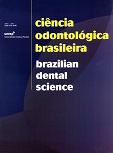A importância da porosidade interna do polímero de mamona durante a neoformação óssea - Estudo em ratos
DOI:
https://doi.org/10.14295/bds.2003.v6i3.598Abstract
Os biomateriais são materiais artificiais desenvolvidos para substituir os tecidos orgânicos que foram danificados, podendo ser usados para preencher defeitos ósseos. Para isto, os biomateriais devem apresentar algumas características, como a biocompatibilidade e boas propriedades estruturais, como a presença de porosidade interna, que é uma condição fundamental para a estabilização e incorporação dos mesmos pelos tecidos vivos. Com o objetivo de se avaliar a importância da porosidade interna do polímero de mamona durante a neoformação óssea, um grupo composto por 45 ratos foi usado. Estes animais sofreram a ressecção de um segmento do arco zigomático direito, que foi imediatamente reconstituído pelo polímero de mamona. Após períodos de proservação de 15, 30, 60, 90 e 120 dias, os animais foram sacrificados e histopatologicamente observados. Os resultados demonstraram a existência de uma neoformação tecidual em meio aos poros do polímero em todos os períodos de avaliação. Uma progressiva diminuição no volume do polímero foi observada, à medida que tecido ósseo era formado em substituição ao polímero. Assim, a estrutura interna do polímero de mamona permitiu a neoformação tecidual, que foi favorável a regeneração do defeito ósseo criado experimentalmente.Downloads
Downloads
Published
How to Cite
Issue
Section
License
Brazilian Dental Science uses the Creative Commons (CC-BY 4.0) license, thus preserving the integrity of articles in an open access environment. The journal allows the author to retain publishing rights without restrictions.
=================




























